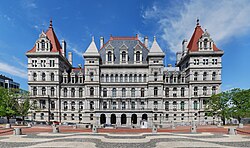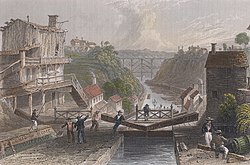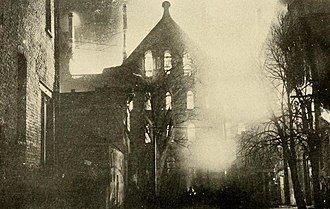
Upstate New York is generally defined as all areas of New York State outside of New York City, Long Island, and the Lower Hudson Valley, although there is no official definition of the area's exact geography. [1][2]
Research your ancestors on MyHeritage
History of Upstate New YorkHistory of Upstate New York

Prior to the arrival of Europeans, New York State was home to a number of Native American tribes.[3][4] The first permanent European settlement was established by the Dutch in 1614 at Fort Nassau, near present-day Albany. [5] New York became one of the original thirteen US colonies, and became the 11th state in 1788. [5] The state is currently divided into 62 counties[6], each of which has a variety of historical and genealogical records. The upstate region was first settled by immigrants from England, Ireland, and Germany.[7] Before Ellis Island became the main point of entry in 1892, more than 10 million immigrants passed through Castle Garden.[8] A number of smaller ports also operated along the New York and Pennsylvania coastlines. [9]Groups of people from the same area often immigrated together, and tended to settle together in their new country. Over time, some of these immigrant families began moving west, into Michigan, Ohio, Illinois, and Minnesota - again, sometimes in groups other than family groups. By 1930, immigration from other countries slowed somewhat due to more restrictive immigration laws, but there was in uptick in African Americans moving north from Virginia, Georgia, and the Carolinas.[10] The 1950s saw people from Jamaica, the West Indies, and Puerto Rico coming to New York state.
Upstate New York genealogy resourcesUpstate New York genealogy resources
The New York State Health Department did not start recording deaths until June 1880, and marriages and births until 1881; however, the law was not well-enforced until 1913 or later.[11] Records prior to this time period may be available through religious institutions, including records of birth, baptism, marriage, and death. Contact churches in the area your ancestor lived to inquire - most are willing to provide copies of records, and will accept a donation as a thank you. If the church your ancestors attended no longer exists, the regional offices or dioceses for that denomination may be able to point you to where the records were moved to. [12]
Towns and villages sometimes recorded some vital records as well - the town or village clerk should be able to tell you what is available, or where you might find the record you are looking for. A local history or genealogy group (in person or online), historical society, or a local library may be able to provide guidance. Be mindful of changing municipal borders over time, which will affect where the record you seek is located. County borders have changed as recently as the 1960s.[13] Local newspapers are also a valuable resource, providing clues about names, relationships, birth, marriage, and death dates, and more.
The New York State Archives houses vital records indices, military service records, land records and maps, court records, and some institutional records (such as correctional facilities and almshouses). [14] Fire insurance maps are also a valuable resource. Sometimes referred to as Sanborn maps, these were prepared from the mid-1800s through the 1950s to assist fire insurance agents in determining the risk associated with insuring a particular property. As a result, they create a record of the size, shape, and construction of homes and businesses, property boundaries, building uses, and house and block numbers. [15]

Beginning in 1825, New York state conducted its own census every ten years until 1875, at the midpoint between federal censuses. State enumerations were done haphazardly after that, happening in 1892, 1905, 1915, and 1925, and was officially abolished in 1931. [16] Because the 1890 federal census was lost in a 1921 fire in Washington, DC, the 1892 New York state census can help us fill in missing information.[17] As with most historical records collections, some have been lost or destroyed. A 1911 fire at the state Capitol in Albany destroyed books and manuscripts, as well as the library's card catalog. Among the lost records were state censuses, marriage bonds, colonial-era manuscripts and commissions, Revolutionary War records, and compiled genealogies.[18] However, copies of or substitutes for some of these records exist.
Upstate New York's colorful history makes it both and exciting and challenging area to research. The wide array of resources available, from very localized to federal, gives researchers a range of information not found everywhere, and can offer unique views into the lives of past generations.
See alsoSee also
Explore more about Upstate New York genealogy researchExplore more about Upstate New York genealogy research
- New York State Marriages, 1881-1952 record collection at MyHeritage
- New York State Death Index, 1880-1956 record collection at MyHeritage
- New York State Deaths, 1957-1972 record collection at MyHeritage
- New York State Death Index, 1880-1956 record collection at MyHeritage
- New York State Marriages, 1881-1952 record collection at MyHeritage
- New York State Death Index, 1880-1956 record collection at MyHeritage
- New York State Marriages, 1881-1952 record collection at MyHeritage
- A Tour of New York State Research Repositories: The Best Part I webinar at Legacy Family Tree webinars
- A Tour of New York State Research Repositories: The Best Part 2 webinar at Legacy Family Tree webinars
- Researching Hudson Valley Palatine Tenant Farmers: Overlooked Resources webinar at Legacy Family Tree webinars
- Up the North River: An Overview of Pre-1800s Hudson Valley Ethnic Groups and Religions webinar at Legacy Family Tree webinars
References
- ↑ Upstate New York - Wikipedia
- ↑ What Area Is Considered Upstate New York? - The New York Times
- ↑ New York - Sports, Recreation, Outdoors | Britannica
- ↑ https://americanindian.si.edu/sites/1/files/pdf/education/HaudenosauneeGuide.pdf
- ↑ 5.0 5.1 United States/New York - MyHeritage Wiki
- ↑ New York State Geography | Department of Labor
- ↑ Upstate New York Roots | Rediscovering Your New York Heritage!
- ↑ Castle Garden Emigrant Depot - Castle Clinton National Monument (U.S. National Park Service)
- ↑ US Ports of Arrival and their Available Passenger Lists and Records
- ↑ Migration History for individual states 1850-2022 - America's Great Migrations
- ↑ Birth, Marriage, and Death Records | New York State Archives
- ↑ Bishops and Dioceses :: NYS Catholic Conference
- ↑ NY: Individual County Chronologies
- ↑ Genealogy | New York State Archives
- ↑ Introduction to the Collection | Articles and Essays | Sanborn Maps | Digital Collections | Library of Congress
- ↑ New York State Census Records Online
- ↑ 1890 Census | National Archives
- ↑ The 1911 State Library Fire And Its Effect On New York Genealogy | New York Genealogical & Biographical Society

